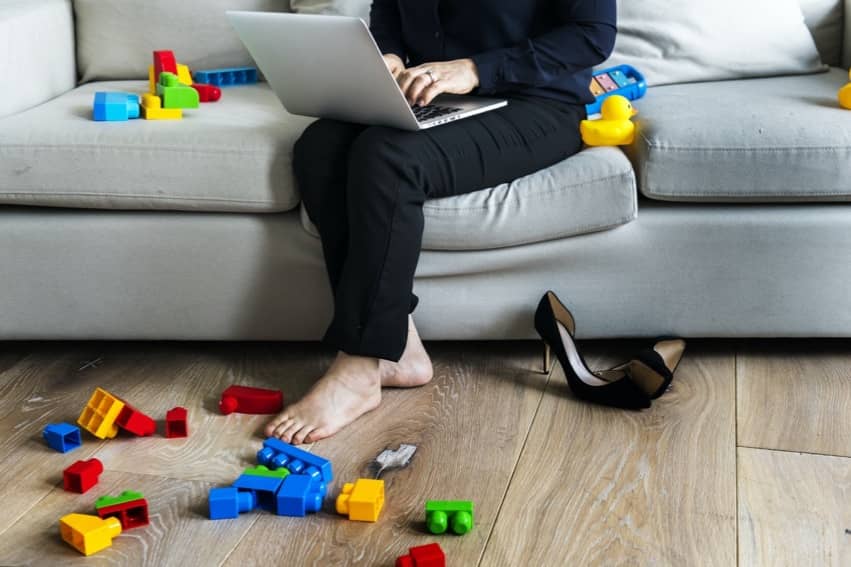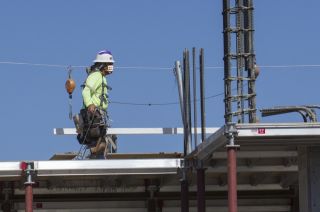
www.buildingsandcities.org/insights/commentaries/working-from-home.html
Will Working from Home Become the New Normal?

During Covid-19 pandemic office buildings are no longer the places where people spend half their waking time.
Chiara Tagliaro explains how the workplace is changing due to the shift to working from home. Key questions and challenges are posed for researchers, practitioners and facility managers: to create a strong evidence base and define appropriate new practices for a range of circumstances and individuals.
Real estate operators and developers are reflecting on what the prospective market trends will be for the office sector. There will be short-term, negative impacts from a major economic downturn following the pandemic, but also workers' new expectations and practices arising from the lockdown. Before forecasting lease prices, m2/ft2 to be built, absorption rates, etc, the most pressing questions are:
- Will office buildings continue to be the same as before?
- When the pandemic is over, will employers and employees want to revert to the 'old office' model?
The major competitors for offices are not coworking spaces nor other 'third places'. The real competitor is everyone's homes (Tagliaro & Ciaramella, 2020). The media are forecasting 'the death of the office' (Nixey, 2020), hinting at a future when no offices will be necessary. On a global scale, the largest remote-work experiment is occurring (Konya, 2020; Memoori, 2020). Working From Home (WHF) has not been studied extensively to date. Consequently, it is still uncertain whether this is more of a benefit or a challenge for both employees and employers, and whether this will be a threat or an opportunity for offices
Knowns and unknowns about WFH
Based on the existing literature, some contend that WFH has very positive effects. Case studies and surveys across firms associate WFH with lower turnover and absenteeism, and with higher profitability and productivity (Council of Economic Advisers, 2014). WFH has positive effects also on family dynamics, as it may reduce work-family conflict, while improving family time and schedule control (Kelly et al., 2014). Moreover, widespread WFH practices can shrink commuting time and distance travelled. These are positive impacts for urban sustainability, by lowering emissions and reducing population densities (i.e. the population and jobs within a defined area) and possibly regenerating suburban areas (Bento, Cropper, Mobarak, & Vinha, 2005).
The first randomized experiment on WFH was conducted on a NASDAQ-listed Chinese travel agency (Bloom, Liang, Roberts, & Ying, 2015). The study confirms that call centre employees WFH improved their performance by 13% compared to office-based colleagues. This was measured through working minutes per shift (fewer breaks and sick days) and number of calls handled per minute (thanks to a quieter working environment). The same workers reported also higher work satisfaction. In the end the company decided to extend the option of WFH to all its employees, but half of those who were in the WFH experiment chose to switch back to working in the office. At the same time, for those who stayed in the WFH mode, performance rose to +22%. Why?
Although the results cannot be generalised to all sectors and types of work, the case study does raise a number of interesting considerations. First, loneliness and lack of social contact are usually the downsides of WFH (Cooper & Kurland, 2002; Golden, Veiga, & Dino, 2008; Spinuzzi, 2012). These were the main drivers for call centre employees returning to the office. Second, WFH scored negative in on-the-job training through a lack of face time. This resulted in lower long-run career opportunities related to an 'out of sight, out of mind' effect and reduced the development of interpersonal skills leading to promotion. Third, the possibility of employees to select their favourite way of working after a trial period plays an important role in the effectiveness of management practices. This is the main factor explaining the increased performance of workers who decided to keep WFH also after the experiment.
These reflections are supported by research arguing that WFH has weird effects on what psychologists and behavioural scientists call arousal, namely a 'continuum of states of energization with physiological, subjective and behavioural expressions' (Matthews & Amelang, 1993). The Yerkes-Dodson Law predicts that the best performance occurs when the level of arousal is optimal. Performance tends to drop both when one is tired or demotivated, and also when one is too excited or stressed out. WFH appears to reflect this inverted U-shape curve (Oseland, 2020a). 'Never-WFH' is likely to cause low performance due to an excess of distractions from colleagues and office noise. However, 'always-WFH' is likely to cause low performance due to an excess in isolation and poor interactions with colleagues. Long-term home workers record high levels of loneliness (Oseland, 2020b) which could negatively affect their performance or increase staff turnover.
Overall, the success of WFH practices highly depend on a few factors. Personality type influences the ability of coping with isolation. Introverts cope better than for extroverts. The nature of tasks assigned to WFH also affects performance. Focused, concentrative and routine work are usually well managed at home (Bloom et al., 2015). However, collaborative activities are more effective when the environment allows in-person interactions. The design of offices and of homes are key factors that can trigger or hinder people's performance at work (Haynes, 2007; Palvalin, Van Der Voordt, & Jylhä, 2017). The Activity-Based Working theory has shaped recent workplaces, based on the assumption that different activities deserve different spaces. This is also one of the design principles and success factors for coworking spaces (Yang, Bisson, & Sanborn, 2019). Perhaps this should be applied more extensively to ascertain how much and what kind of work should be done at the office and at home.
Making WFH successful
Major corporate real estate changes were predicted after previous disasters (e.g. 9/11). These predictions included: reduced commuting through greater use of teleconferencing and videoconferencing; widespread adoption of homeworking; expansion of distributed work-location strategies through satellite and neighbourhood work centres; implementation of hoteling policies; and the creation of stronger communities within organizations (Laing, 2003). These were not abrupt changes that manifested only after 9/11. Instead, these were existing tendencies that proceeded at a greater pace after those dramatic events.
Similarly, in the post-Covid-19 world of work, the evolution of the workplace will continue. Several important questions deserve further attention from researchers and practitioners to provide a strong evidence base and appropriate practices:
1. What constitutes better measures of performance for high value-added jobs, at both individual and organizational level? These might include (but are not limited to) work productivity, level of arousal, personality traits of employees, individual and group tasks, but also carbon footprint, and avoided CO2 emissions
2. What regular practices should be used to track actual performance? What management practices can help employees to determine their preferred work mode?
3. How can workplace design be improved to support employees especially for specific activities (e.g. explicit and tacit knowledge exchange, socialization, and inspiration)?
4. What roles, responsibilities and assistance does the organisation have in supporting WFH? What are the spatial and infrastructure requirements for WFH? What new or additional costs are exported to the homeworker? How are those costs apportioned?
5. What hybrid spaces are needed to make more efficient use of underutilized or temporary utilized spaces? For instance, resiliency planning for extreme events could entail turning empty retail spaces or restaurants into workplaces, in order to spread out the workforce and enforce social distancing when necessary.
6. What are the wider urban and social impacts of dispersed working? Will this stimulate rural / suburban coworking (Mariotti & Di Matteo, 2020). This would have a massive effect in (a) reducing carbon emissions from travel, (b) engendering significant movements back to abandoned villages and shrinking towns, (c) downsizing corporate real estate portfolios and office building footprint, and (d) providing relocated workers with more contact with the nature.
7. A decreased amount of work time for staff is an issue policy makers and individual organizations. What is an optimum balance between work and rest, leisure and contemplation? In light of several recent experiments of reduced working hours (e.g. Glaveski, 2018; Graham-McLay, 2018), the advantages are becoming clear for reducing the amount of time devoted to work.
All the above-mentioned elements share a common thread in the need for a systemic, cross-disciplinary approach to the workplace. The areas of health, safety and security management, facility management, corporate social responsibility management, organizational management, as well as space planning, design, architecture, and urban planning can no longer avoid each other but must work together harmoniously. This is hopefully going to be the unprecedented 'new normal' of the workplace.References
Bento, A. M., Cropper, M. L., Mobarak, A. M., & Vinha, K. (2005). The effects of Urban spatial structure on travel demand in the United States. Review of Economics and Statistics, 87(3), 466-478. https://doi.org/10.1162/0034653054638292
Bloom, N., Liang, J., Roberts, J., & Ying, Z. J. (2015). Does Working from Home Work? Evidence from a Chinese Experiment. The Quarterly Journal of Economics, 130(1), 165-218. https://doi.org/10.1093/qje/qju032
Cooper, C. D., & Kurland, N. B. (2002). Telecommuting, professional isolation, and employee development in public and private organizations. Journal of Organizational Behavior J. Organiz. Behav, 23, 511-532. https://doi.org/10.1002/job.145
Glaveski, S. (2018, December 11). The Case for the 6-Hour Workday. Retrieved May 10, 2020, from https://hbr.org/2018/12/the-case-for-the-6-hour-workday
Golden, T. D., Veiga, J. F., & Dino, R. N. (2008). The Impact of Professional Isolation on Teleworker Job Performance and Turnover Intentions: Does Time Spent Teleworking, Interacting Face-to-Face, or Having Access to Communication-Enhancing Technology Matter? Journal of Applied Psychology, 93(6), 1412-1421. https://doi.org/10.1037/a0012722
Graham-McLay, C. (2018, July 19). A 4-Day Workweek? A Test Run Shows a Surprising Result - The New York Times. Retrieved May 10, 2020, from https://www.nytimes.com/2018/07/19/world/asia/four-day-workweek-new-zealand.html
Haynes, B. P. (2007). Office productivity: a theoretical framework. Journal of Corporate Real Estate, 9(2), 97-110. https://doi.org/10.1108/14630010710828108
Kelly, E. L., Moen, P., Oakes, J. M., Fan, W., Okechukwu, C., Davis, K. D., … Casper, L. M. (2014). Changing Work and WorkvFamily Conflict: Evidence from the Work, Family, and Health Network. American Sociological Review, 79(3), 485-516. https://doi.org/10.1177/0003122414531435
Konya, K. (2020, March 21). SURVEY: How Coworking Spaces are Navigating COVID-19. Retrieved April 7, 2020, from https://www.coworker.com/mag/survey-how-coworking-spaces-are-navigating-covid-19
Laing, A. M. (2003). Re-thinking corporate real estate after September 11th. Journal of Corporate Real Estate, 5(4), 273-292. https://doi.org/10.1108/14630010310812172
Mariotti, I., & Di Matteo, D. (2020). Coworking in emergenza Covid-19: quali effetti per le aree periferiche? EyesReg, 10(2), 1-6.
Matthews, G., & Amelang, M. (1993). Extraversion, arousal theory and performance: A study of individual differences in the EEG. Personal Individual Differences (Vol. 14).
Memoori. (2020, March 19). COVID-19, the Worlds Biggest Remote Working Experiment is Underway. Retrieved April 7, 2020, from https://memoori.com/covid-19-the-worlds-biggest-remote-working-experiment-is-underway/
Nixey, C. (2020, June). The death of the office. Retrieved May 10, 2020, from https://www.1843magazine.com/features/death-of-the-office
Oseland, N. (2020a). Working from Home - A Psychological and Personality Perspective. Retrieved May 5, 2020, from https://workplaceunlimited.blogspot.com/2020/05/working-from-home-psychological-and.html
Oseland, N. (2020b, March 25). Loneliness has always been a workplace issue - Workplace Insight. Retrieved May 10, 2020, from https://workplaceinsight.net/why-loneliness-is-a-workplace-issue/
Palvalin, M., Van Der Voordt, T., & Jylhä, T. (2017). The impact of workplaces and self-management practices on the productivity of knowledge workers. Journal of Facilities Management, 15(4), 423-438. https://doi.org/10.1108/JFM-03-2017-0010
Spinuzzi, C. (2012). Working Alone Together: Coworking as Emergent Collaborative Activity. Journal of Business and Technical Communication, 26(4), 399-441. https://doi.org/10.1177/1050651912444070
Tagliaro, C., & Ciaramella, A. (2020). Co.Co.Co. Continuare il Coworking con Covid-19? EyesReg, (forthcoming)
The Council of Economic Advisers. (2014). Work-Life Balance and the Economics of Workplace Flexibility.
Yang, E., Bisson, C., & Sanborn, B. E. (2019). Coworking space as a third-fourth place: changing models of a hybrid space in corporate real estate. Journal of Corporate Real Estate, 21(4), 324-345. https://doi.org/10.1108/JCRE-12-2018-0051
Yerkes, R. M., & Dodson, J. D. (1908). The relation of strength of stimulus to rapidity of habit-formation. Journal of Comparative Neurology and Psychology, 18(5), 459-482. https://doi.org/10.1002/cne.920180503
Latest Peer-Reviewed Journal Content
Built environment governance and professionalism: the end of laissez-faire (again)
S Foxell
Co-creating justice in housing energy transitions through energy living labs
D Ricci, C Leiwakabessy, S van Wieringen, P de Koning & T Konstantinou
HVAC characterisation of existing Canadian buildings for decarbonisation retrofit identification
J Adebisi & J J McArthur
Simulation and the building performance gap [editorial]
M Donn
Developing criteria for effective building-sector commitments in nationally determined contributions
P Graham, K McFarlane & M Taheri
Reimagining circularity: actions for optimising the use of existing buildings
R Lundgren, R Kyrö, S Toivonen & L Tähtinen
Effective interdisciplinary stakeholder engagement in net zero building design
S Vakeva-Baird, F Tahmasebi, JJ Williams & D Mumovic
Metrics for building component disassembly potential: a practical framework
H Järvelä, A Lehto, T Pirilä & M Kuittinen
The unfitness of dwellings: why spatial and conceptual boundaries matter
E Nisonen, D Milián Bernal & S Pelsmakers
Environmental variables and air quality: implications for planning and public health
H Itzhak-Ben-Shalom, T Saroglou, V Multanen, A Vanunu, A Karnieli, D Katoshevski, N Davidovitch & I A Meir
Exploring diverse drivers behind hybrid heating solutions
S Kilpeläinen, S Pelsmakers, R Castaño-Rosa & M-S Miettinen
Urban rooms and the expanded ecology of urban living labs
E Akbil & C Butterworth
Living with extreme heat: perceptions and experiences
L King & C Demski
A systemic decision-making model for energy retrofits
C Schünemann, M Dshemuchadse & S Scherbaum
Modelling site-specific outdoor temperature for buildings in urban environments
K Cebrat, J Narożny, M Baborska-Narożny & M Smektała
Understanding shading through home-use experience, measurement and modelling
M Baborska-Narożny, K Bandurski, & M Grudzińska
Building performance simulation for sensemaking in architectural pedagogy
M Bohm
Beyond the building: governance challenges in social housing retrofit
H Charles
Heat stress in social housing districts: tree cover–built form interaction
C Lopez-Ordoñez, E Garcia-Nevado, H Coch & M Morganti
An observational analysis of shade-related pedestrian activity
M Levenson, D Pearlmutter & O Aleksandrowicz
Learning to sail a building: a people-first approach to retrofit
B Bordass, R Pender, K Steele & A Graham
Market transformations: gas conversion as a blueprint for net zero retrofit
A Gillich
Resistance against zero-emission neighbourhood infrastructuring: key lessons from Norway
T Berker & R Woods
Megatrends and weak signals shaping future real estate
S Toivonen
A strategic niche management framework to scale deep energy retrofits
T H King & M Jemtrud
Generative AI: reconfiguring supervision and doctoral research
P Boyd & D Harding
Exploring interactions between shading and view using visual difference prediction
S Wasilewski & M Andersen
How urban green infrastructure contributes to carbon neutrality [briefing note]
R Hautamäki, L Kulmala, M Ariluoma & L Järvi
Implementing and operating net zero buildings in South Africa
R Terblanche, C May & J Steward
Quantifying inter-dwelling air exchanges during fan pressurisation tests
D Glew, F Thomas, D Miles-Shenton & J Parker
Western Asian and Northern African residential building stocks: archetype analysis
S Akin, A Eghbali, C Nwagwu & E Hertwich



Latest Commentaries
Building-Related Research: New Context, New Challenges
Raymond J. Cole (University of British Columbia) reflects on the key challenges raised in the 34 commissioned essays for Buildings & Cities 5th anniversary. Not only are key research issues identified, but the consequences of changing contexts for conducting research and tailoring its influence on society are highlighted as key areas of action.
Lessons from Disaster Recovery: Build Better Before
Mary C. Comerio (University of California, Berkeley) explains why disaster recovery must begin well before a disaster occurs. The goal is to reduce the potential for damage beforehand by making housing delivery (e.g. capabilities and the physical, technical and institutional infrastructures) both more resilient and more capable of building back after disasters.